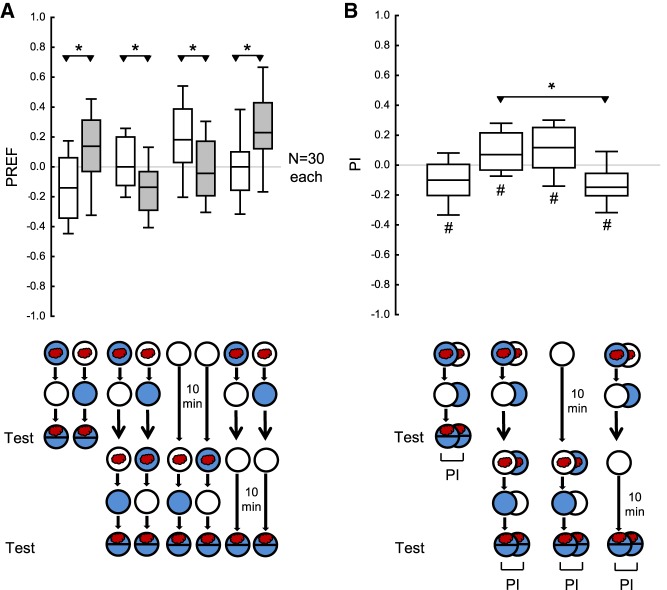Figure 7.
Absolute aversive reversal learning paradigm in larval Drosophila. The larvae were trained as in Figure 5 with modifications for measuring reversal learning in the aversive domain. Specifically, (i) a high concentration of salt (sodium chloride) was used as the punishment (blue fill of Petri dish); (ii) only one cycle of training was given in the first training phase; (iii) the duration of individual training trials and the duration of the test were 5 min each; (iv) agarose Petri dishes with neither odor nor punishment were used for maintaining the larvae when omitting the first or the second training phase; and (v) the test was performed on salt-containing Petri dishes. (A) The larvae were tested either (i) immediately after one-phase training, (ii) after training with reversed contingencies in the first and the second training phase, (iii) after omitting the first training phase, or (iv) after omitting the second training phase. (B) PIs calculated from the preference scores in A. Negative and positive PIs indicate aversive memory related to the first and the second training phase, respectively. The PIs after reversed-contingency training were more positive than when the second training phase was omitted, suggesting behavior in accordance with the second training phase. In addition, the PI after reversed-contingency training were significantly positive, confirming this conclusion. The fact that the PIs were significantly negative when the second training phase was omitted suggests behavior in accordance with the first training phase. However, the PIs were no less positive after reversed-contingency training than when the first training phase was omitted, offering no evidence for a behavioral effect of the memory for the first training phase. Sample sizes are given within the figure. * refers to MWU comparisons between groups, # refers to OSS comparisons to chance levels, that is, to zero (*,# P < 0.05 corrected according to Bonferroni-Holm). Other details as in Figures 1–6.

